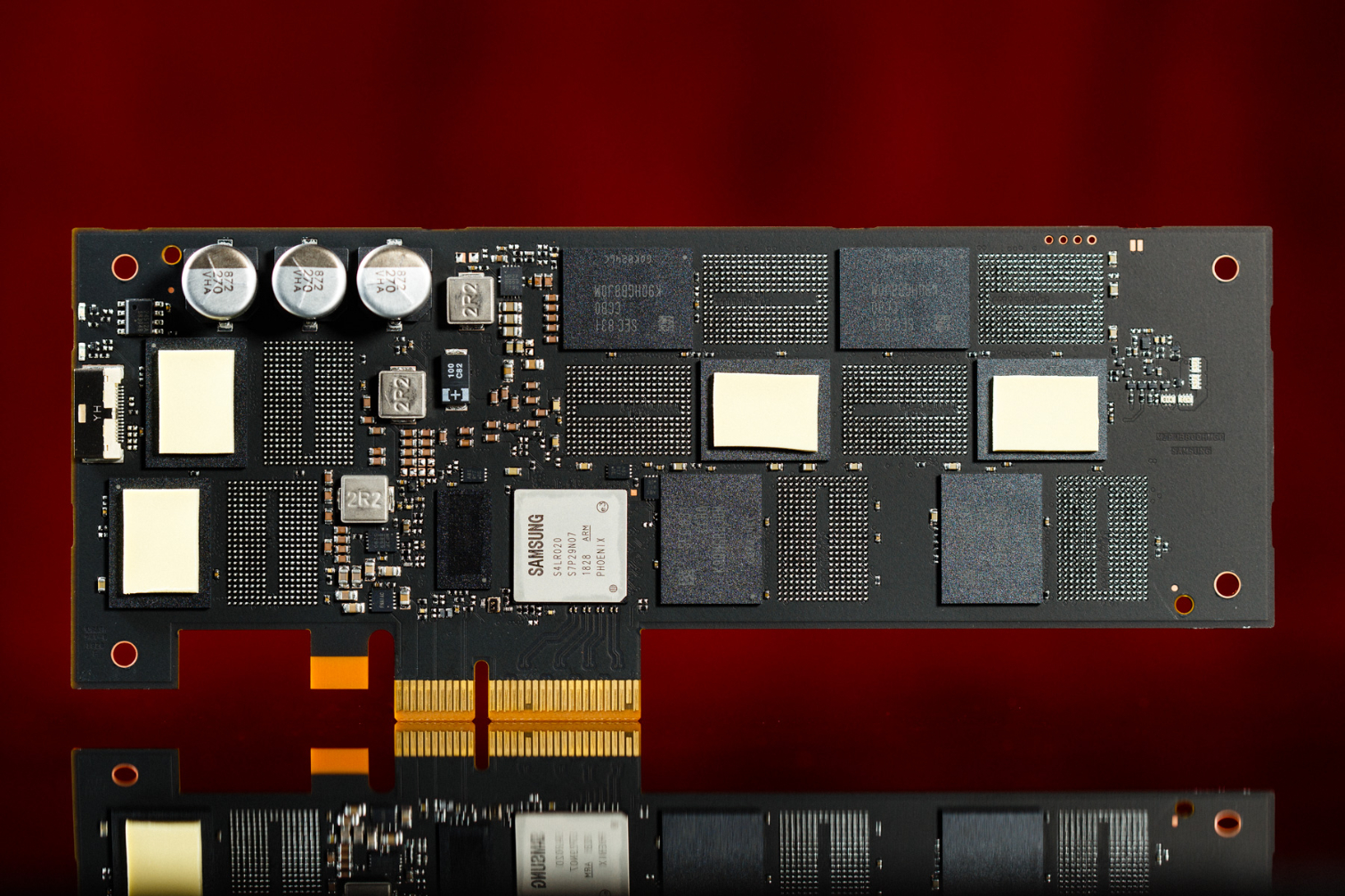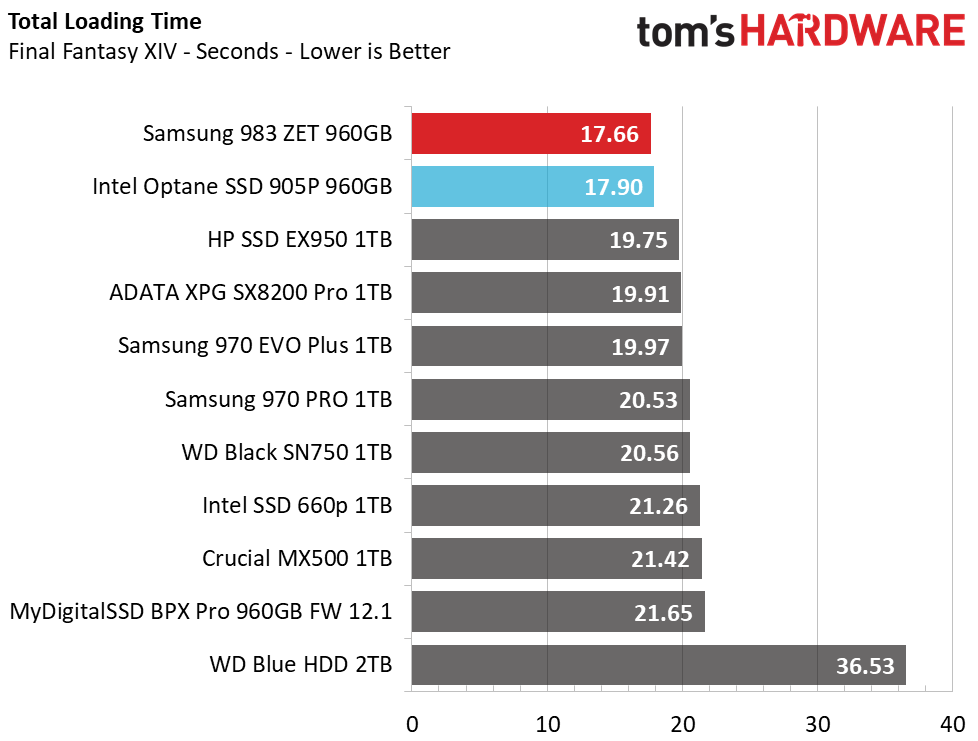Intel Optane vs Samsung Z-NAND: SSD Memory Face-Off
In 2019, there’s just no reason to boot a PC off of anything but a Solid State Drive. And, if you care about performance, you’ll want a drive that uses the speedy NVMe interface and the best possible memory. While most SSDs still use some form of NAND flash, Intel and Samsung have developed their own high-speed alternatives in the form of Optane (aka 3D Xpoint) and Z-NAND, respectively.
At this point, only a handful of Intel-branded SSDs use Optane memory and a pair of Samsung enterprise drives have Z-NAND. But if you’re seeking the best storage performance money can buy, a drive using one of these technologies should be on short list.
So which is better? To find out, we put the Optane and Z-NAND through a seven-round face-off, using numbers from 960GB capacities of the Intel Optane 905P and Samsung 983 ZET. But first, let’s take a look at how these memory types work.
Intel Optane (3D XPoint)
Intel’s Optane is the first solid-state memory based on the 3D XPoint technology Team Blue developed in cooperation with Micron (Micron plans to come out with its own 3D XPoint-based devices later this year). In Optane, submicroscopic layers of material are cut into columns leaving each column with a memory cell and selector. Then wires are perpendicularly connected to the top and bottom of the columns to make up the crosspoint structure.
Unlike conventional NAND, this memory doesn’t store electrons in a charge trap or floating gate array to hold bits of information. Instead, a 1 or an 0 is designated based on the cell material’s resistance level. The memory cells can be individually addressed by selecting one wire on top and one on the bottom. They are then read or written to by varying the amount of voltage sent to each selector. This causes a bulk property change which results in the material changing the cell to a high or low resistance state and is a huge factor as to why it is so fast.
Because 3D XPoint can be individually addressed, there is no need for garbage collection, the read-modify-write process that helps to reclaim occupied cells where data was deleted. Since garbage collection eats up the devices' compute resources, the lack of it makes Optane faster than NAND under write heavy workloads. Along with its material properties, it also helps Optane withstand significantly more writes over its lifetime and exhibit a much lower latency profile.
Samsung Z-NAND
Samsung’s Z-NAND (aka Low Latency V-NAND) is that company’s answer to Optane. While Z-NAND is burdened with many of the same drawbacks as normal flash to some extent, its design enables performance that is closer to that of 3D XPoint than normal NAND.
Get Tom's Hardware's best news and in-depth reviews, straight to your inbox.
Built off of a modified V-NAND design, Z-NAND currently utilizes 48 layers and functions in single level cell (SLC) mode, so each cell can only have a charge level of a 1 or a 0. MLC, TLC, and QLC NAND all have more voltage states which reduce performance and endurance. Thus, they need more powerful and complex ECC algorithms in order to prevent data read errors and are slower.
Z-NAND features page sizes as small as 2-4 KB where normal NAND pages are 8-16 KB. This, in turn, helps to provide more parallelism so that the drive can read and write smaller chunks of data at a faster pace. It also helps reduce latency.
Latency Performance
We’ve all been there. You click on an application or file, watching a spinning circle logo, and a few moments later it finally opens. SSDs with traditional NAND offer significantly lower latency than a traditional HDD, which helps make requests nearly instant, but Z-NAND and 3D XPoint drives are even better.
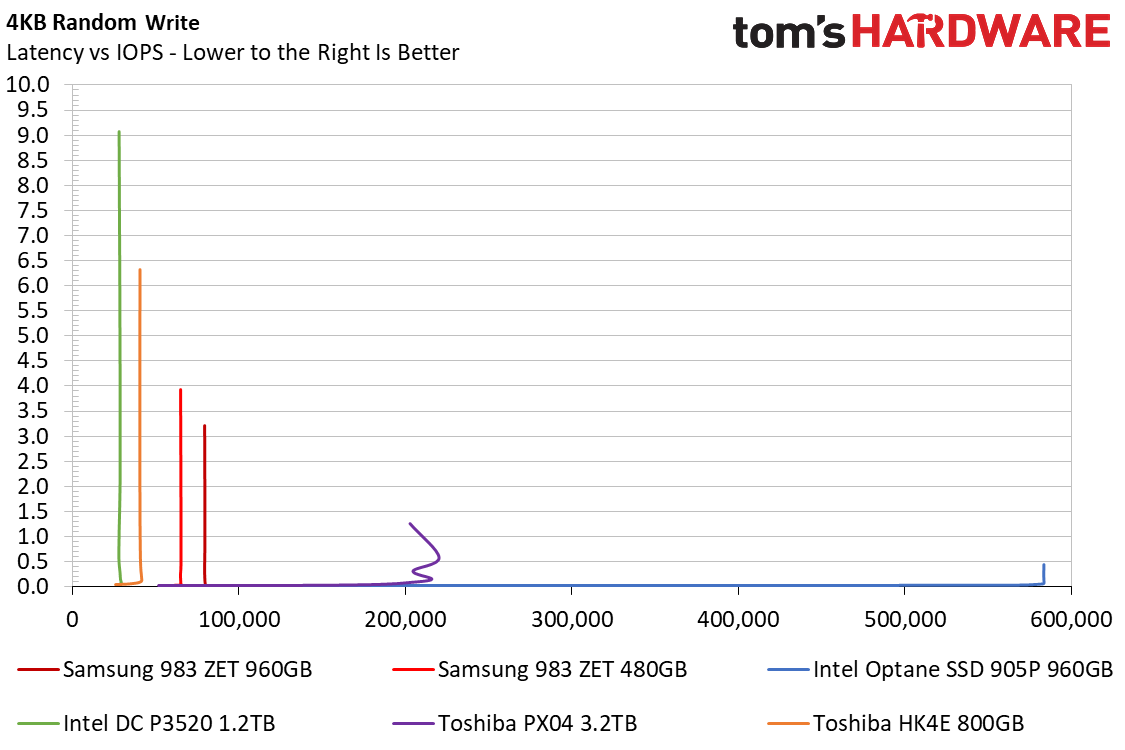




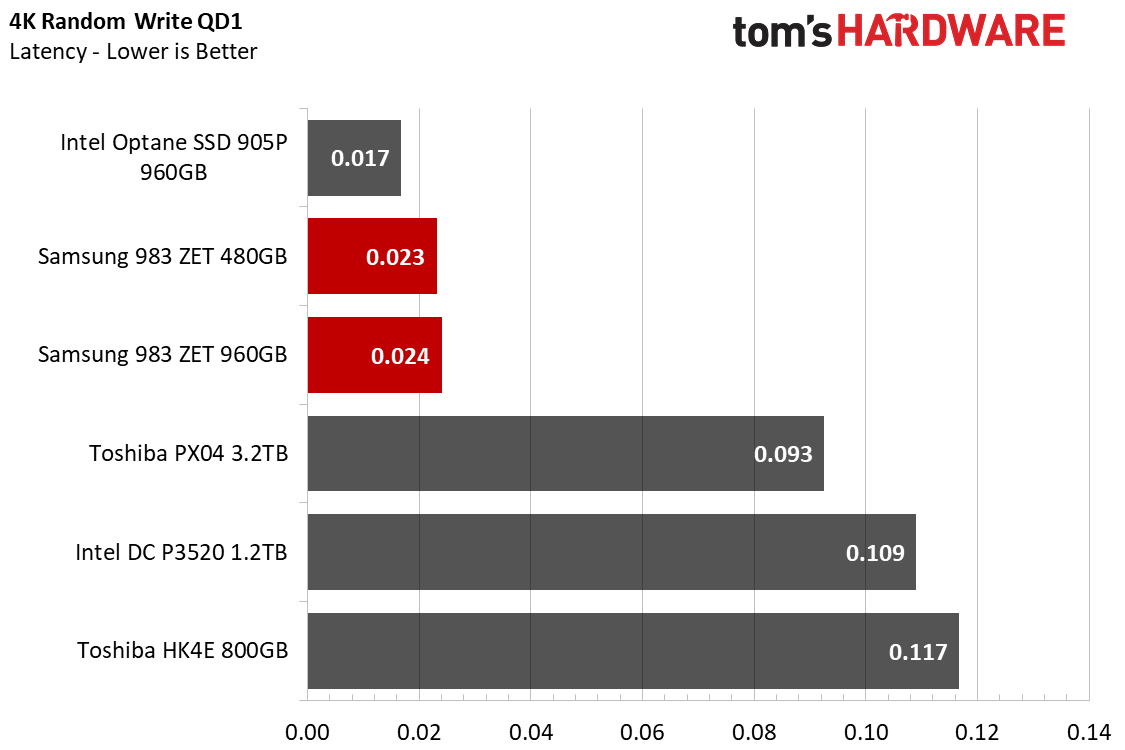
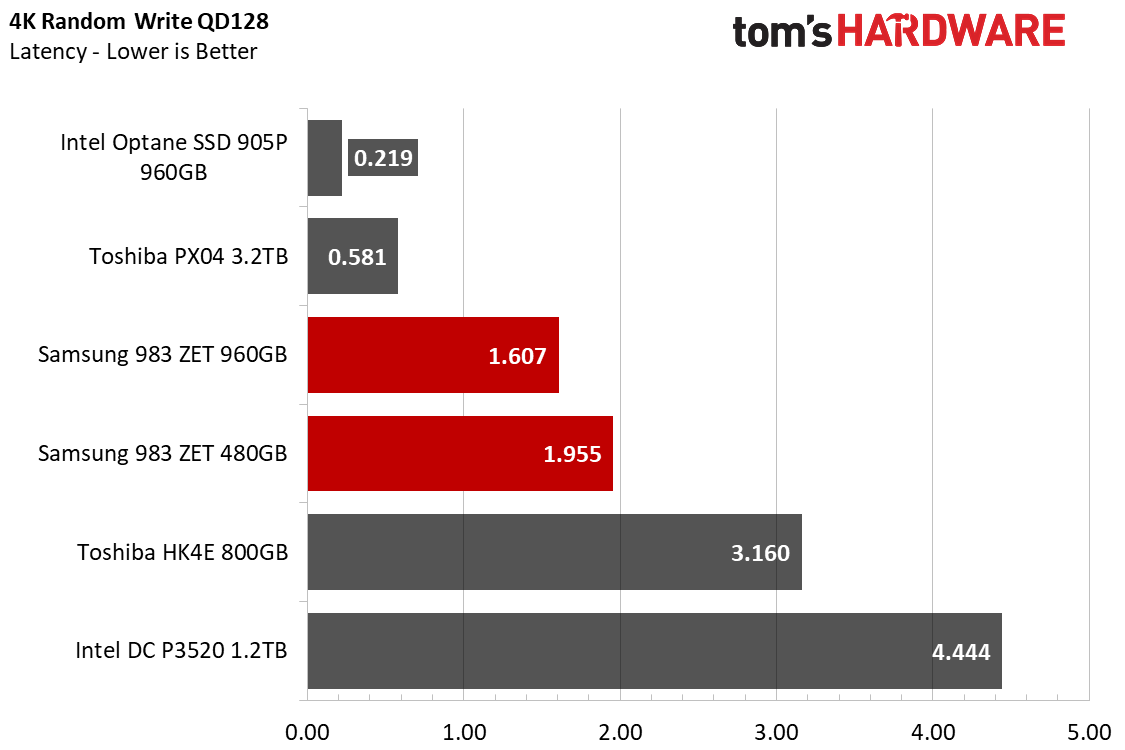





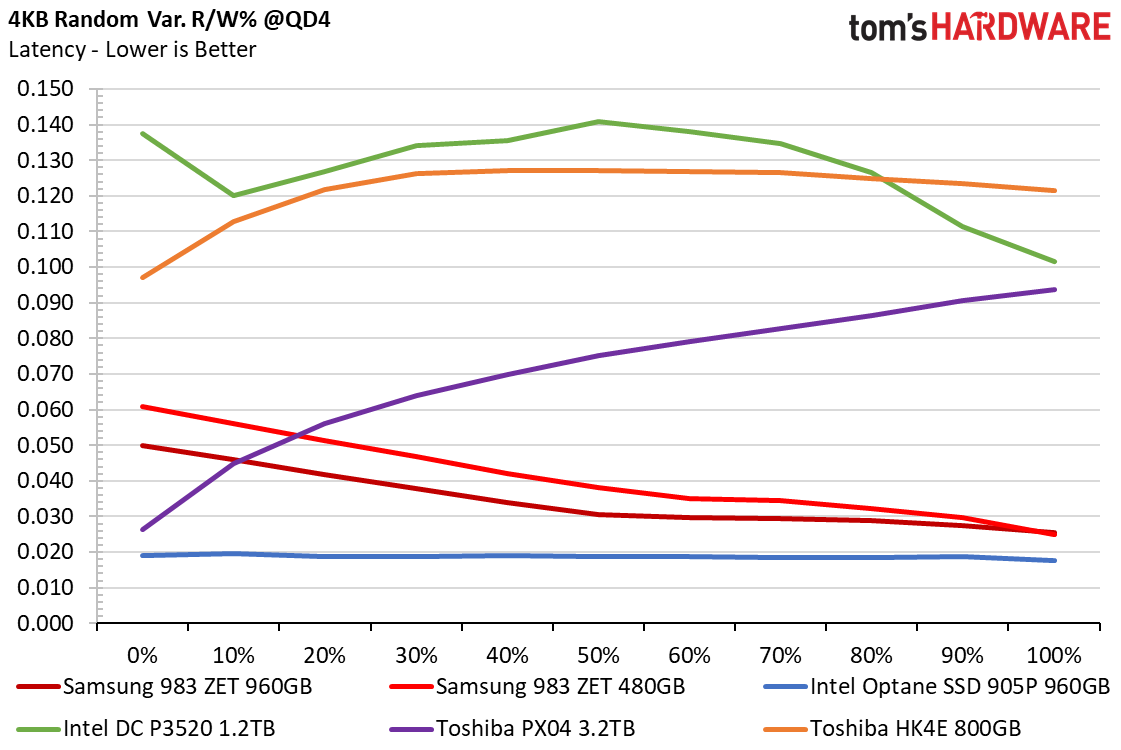



At a QD of 1, a 4KB random read/write request on the 983 ZET has a latency of about 0.023-0.024ms, or something that is about 1/4th that of regular SSDs. The 3D XPoint based Intel Optane SSD 905P, however, is much better with a latency of 0.017ms.
And, on top of that, it is able to maintain that low latency during both reads and writes. The only time the 983 ZET outperformed the 905P was outperformed was during 4K random reads at QD32 and up, and during sequential read or write workloads.
Winner: Intel Optane. Since most enterprise workloads are around the QD 1-16 range and are often mixed in nature, we award this round to Intel. Optane is the lowest latency storage medium we have tested to date.
Random Performance
Because it doesn’t need to perform garbage collection, the Intel 905P delivers fast and consistent IOPS, and thus, makes random performance Optane’s strong suit. Whether during during pure reads or writes, or a mix of both, Optane delivers some of the fastest performance we’ve seen non-stop at queue depths where it matters.
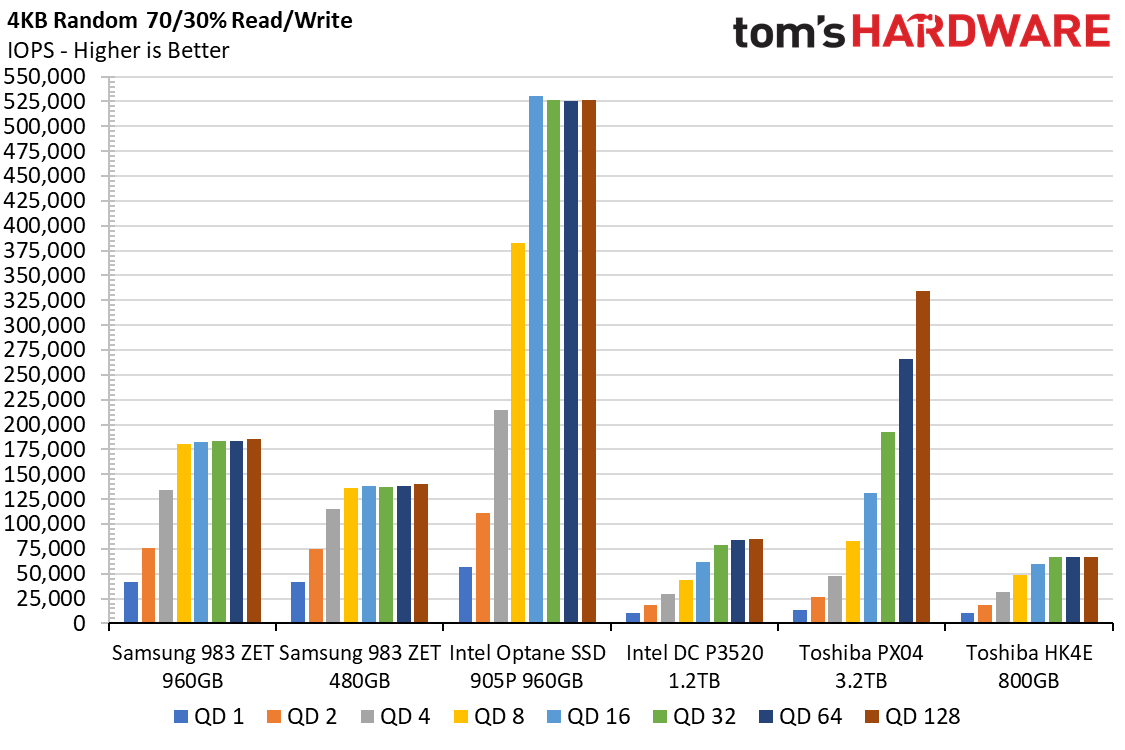



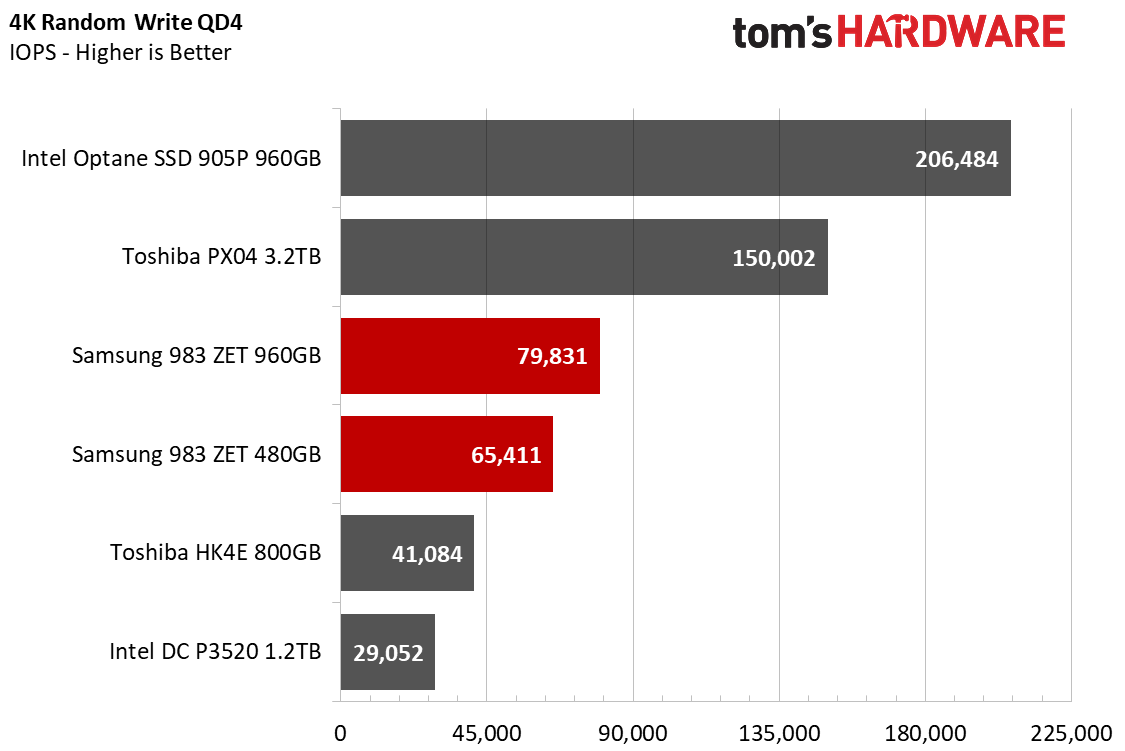


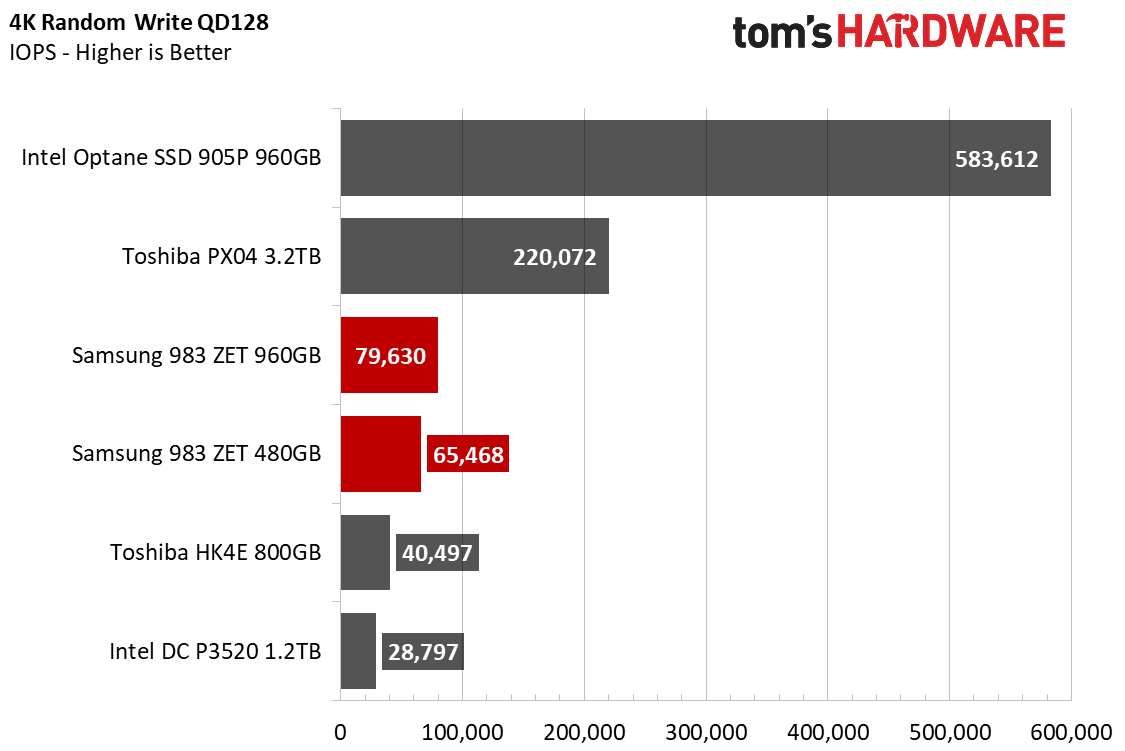








At a QD of 1, the Intel Optane SSD 905P delivered 58/53k IOPS read/write, and at QD4, about quadruple that. At a QD of 128 it maxed out at ~580K IOPS read/write. It even attained an average of 526K IOPS during a 70/30% read/write mix.
While random performance is 3D XPoint’s specialty, the 983 ZET with its Z-NAND is no slouch, though. Z-NAND takes the win at high QDs of 32 and beyond. At QD 128 it delivers nearly 800K IOPS while the Optane 905P delivers 580K IOPS.
At QD1-4, the Samsung drive’s performance is close to the 905P, but once you throw in some writes, performance trails behind 3D XPoint and is rather limited to a max of 75K IOPS. The SZ985 can deliver up to 170K IOPS write, but that is still nowhere near the Intel 905P’s 580K IOPS write performance.
Winner: Intel Optane. When it comes to consistent random performance, Intel’s memory delivers where others can’t.
Sequential Performance
Sequential performance matters most when you have multi-GB sized files and you want to access or move them around. Even most games’ file loading is sequential in nature. Here, the Z-NAND based drives have an edge over their Optane-based competitors.





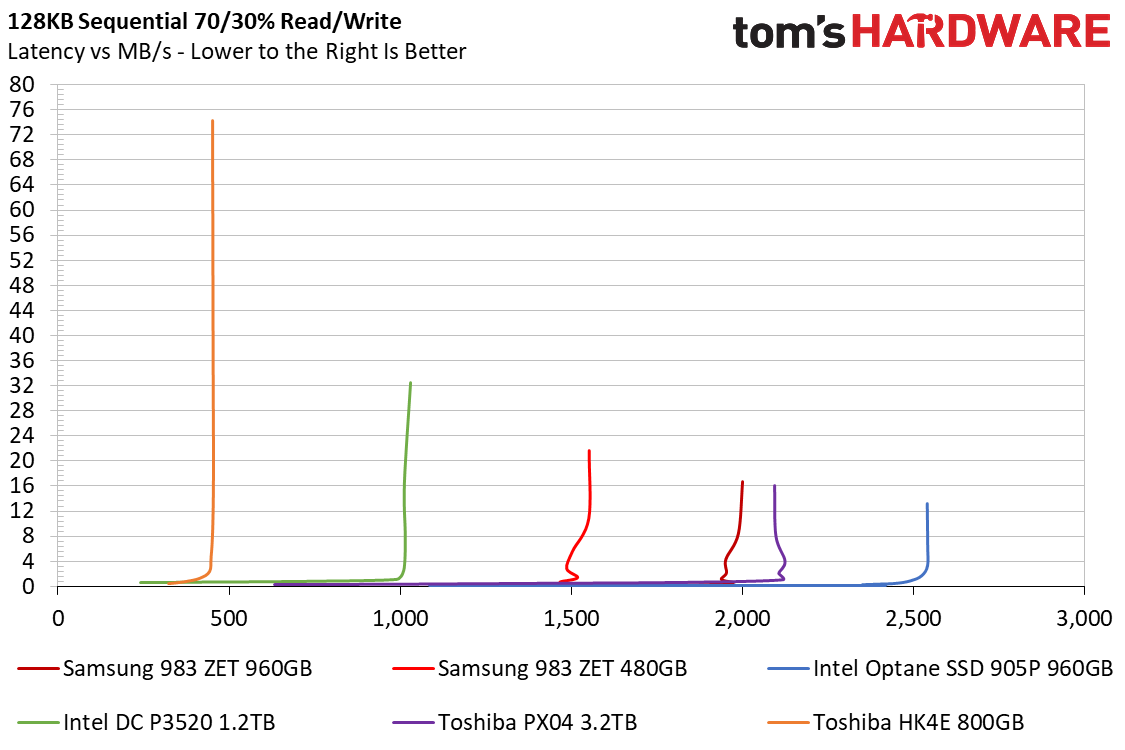


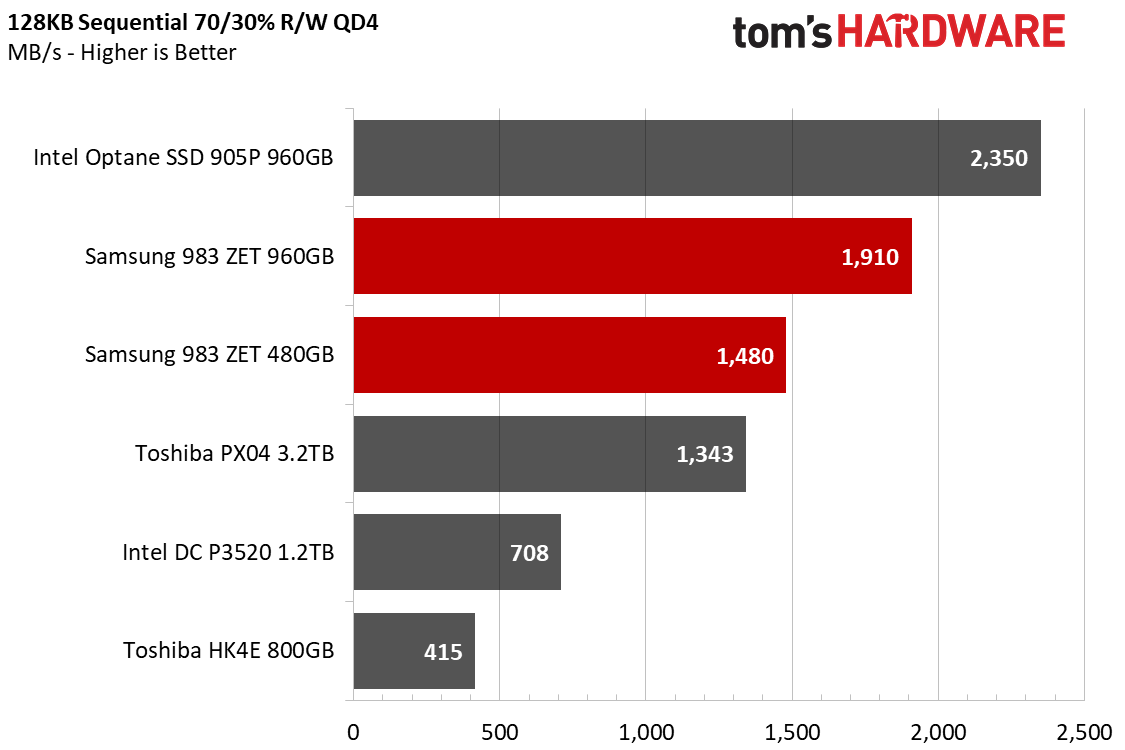



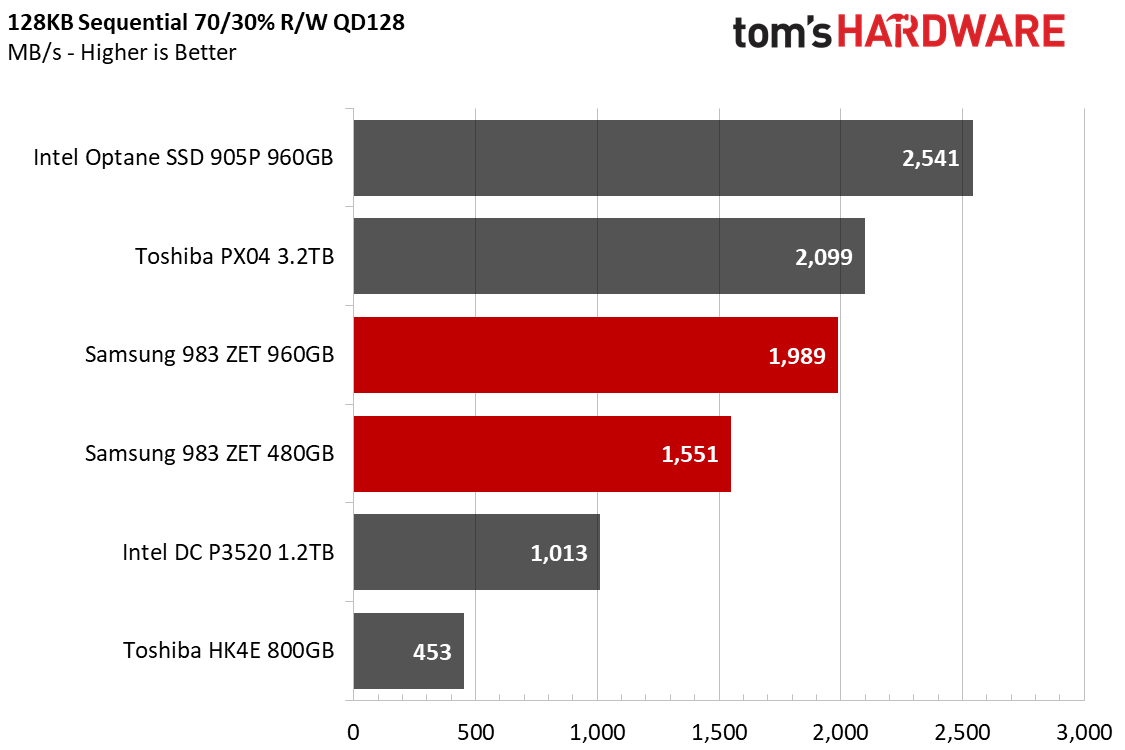


We’re not quite sure if it is due to the controller or the memory itself that limits the Intel Optane SSDs, but most are limited to sequential throughput of about 2.5-2.7GB/s. The 983 ZET uses Samsung’s consumer-class Phoenix SSD controller, which enables sequential speeds of up to 3.4GB/s. Even at a QD of 1, Samsung’s Z-NAND based SSD is able to outperform the Intel 905P with reads/writes at 2-2.1GB/s.
Winner: Samsung Z-NAND. With superior sequential read/write performance, Samsung’s Z-NAND wins this round.
Game Load Performance
One of the most frustrating parts of PC gaming is sitting there tapping your thumbs and waiting for levels to load. To find out which storage technology is best for gaming, we used the Final Fantasy XIV StormBlood test, which is a free real-world game benchmark that easily and accurately compares game load times, no stopwatch required.
With the ability to dish out nearly 800K random read IOPS and sequential throughput of up to 3.5GB/s in consumer products, Samsung’s Phoenix controller is quite capable. It is only natural to expect strong game load performance after seeing its stats.
But, we didn’t think the 983 ZET would actually beat Intel’s 905P. Here, we see that Z-NAND is able to outperform Intel’s 3D XPoint ever so slightly due to faster sequential performance, where the 905P is somewhat limited.
Winner: Samsung Z-NAND. With better sequential read performance at QD1, the 983 ZET was able to outperform Intel’s Optane SSD 905P in game scene loading.
Productivity/Application Performance
For productivity comparison, we used two very well-known software suites. The first is PCMark 8’s trace-based Storage Test 2.0. This test utilizes Microsoft Office, Adobe Creative Suite, World of Warcraft, and Battlefield 3 to measure the performance of storage devices in real-world scenarios. The other is SYSmark 2014 SE, an application-based test, similar to PCMark 8, but it utilizes more applications and even has multiple operations going on at once in order to paint a more realistic picture of performance.



In PCMark 8, both the 983 ZET and 905P deliver incredibly high scores. The 983 ZET scored 5,140 points and an average bandwidth of 1423MB/s. Intel’s 905P, however still bested it with a score of 5144 points and an average bandwidth of 1609MB/s.
SYSmark 2014 SE shows a similar result. While the 983 ZET scored higher than any other NAND based drive we have tested, Intel’s 905P still outperformed it ever so slightly by three points.
Winner: Intel Optane. Even with lower sequential performance, Intel’s memory proves that its ultra-low latency and high random IOPS at low queues makes it the fastest storage medium when you want to get things done.
Endurance
The one drawback to SSD technology is that all drives can only absorb a limited number of writes before they eventually wear out. For most consumers, who write in the range of 10 to 20GB a day, it would take many years to wear out even the cheapest NAND-based SSD. However, large businesses that want to use SSDs in servers or workstations have tougher endurance requirements.
The good news is that both Optane and Z-NAND-based products have incredible endurance figures. The Samsung 983 ZET and Intel Optane SSD 905P share the same endurance rating of about 17.5 Petabytes written (PBW). To put that into perspective, that's about two centuries worth of consumer writes (20GB/day * 365 days/year * 2000 years = 14.6 PB). Basically, both can take almost any workload you throw at it for as long as you need.
Stretching out to the enterprise grade Intel Optane DC P4800X, we can see that it features an endurance rating of 41 PBW at the 750GB capacity. As well, the ZET’s bigger brother, the Samsung ZS985, can absorb a very similar amount of writes too, up to 43.8 PBW at the 800GB capacity.
However, when looking to smaller 375GB and 480GB capacities of 3DXPoint and Z-NAND based products, we can see that Intel’s DC P4800X can withstand almost three times the number of writes than the 983 ZET, and the 905P at 480GB can withstand a little over a PB more of data written, too.
Draw: Both storage mediums demonstrate very high endurance and trade blows depending on the final product and capacity.
Power Efficiency
Power consumption is an important piece of the puzzle when it comes to your computer hardware, even storage. You wouldn’t want a storage device drawing as much power as a CPU or GPU, would you?







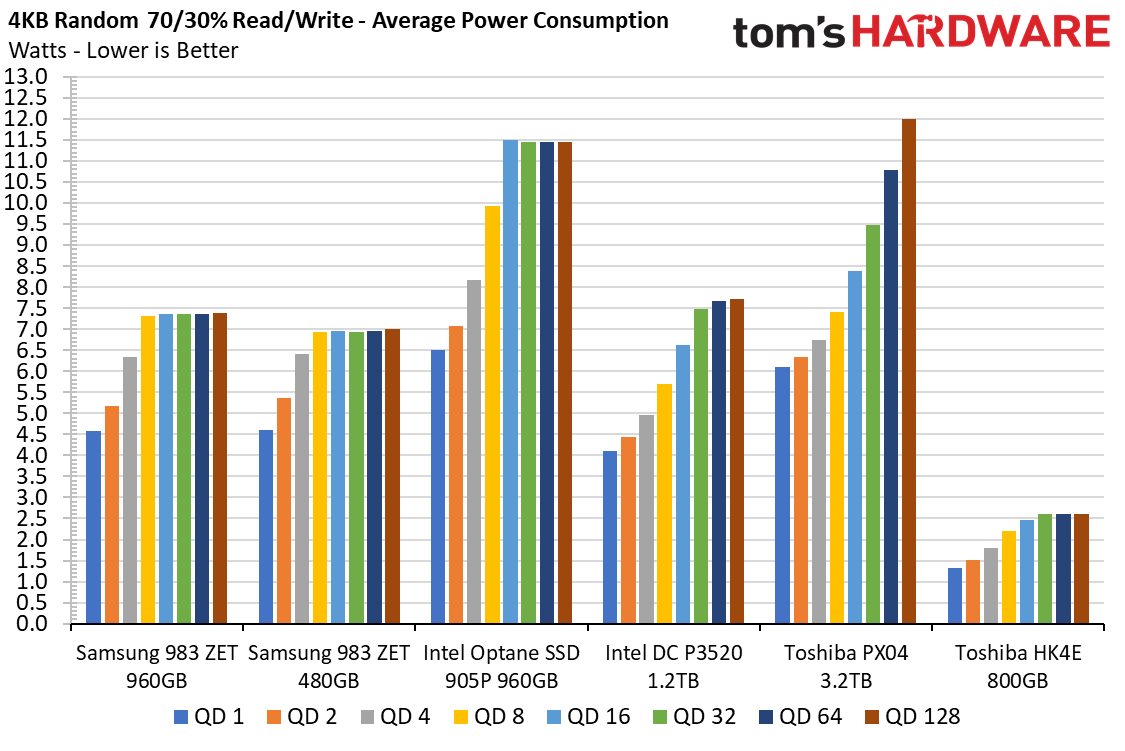







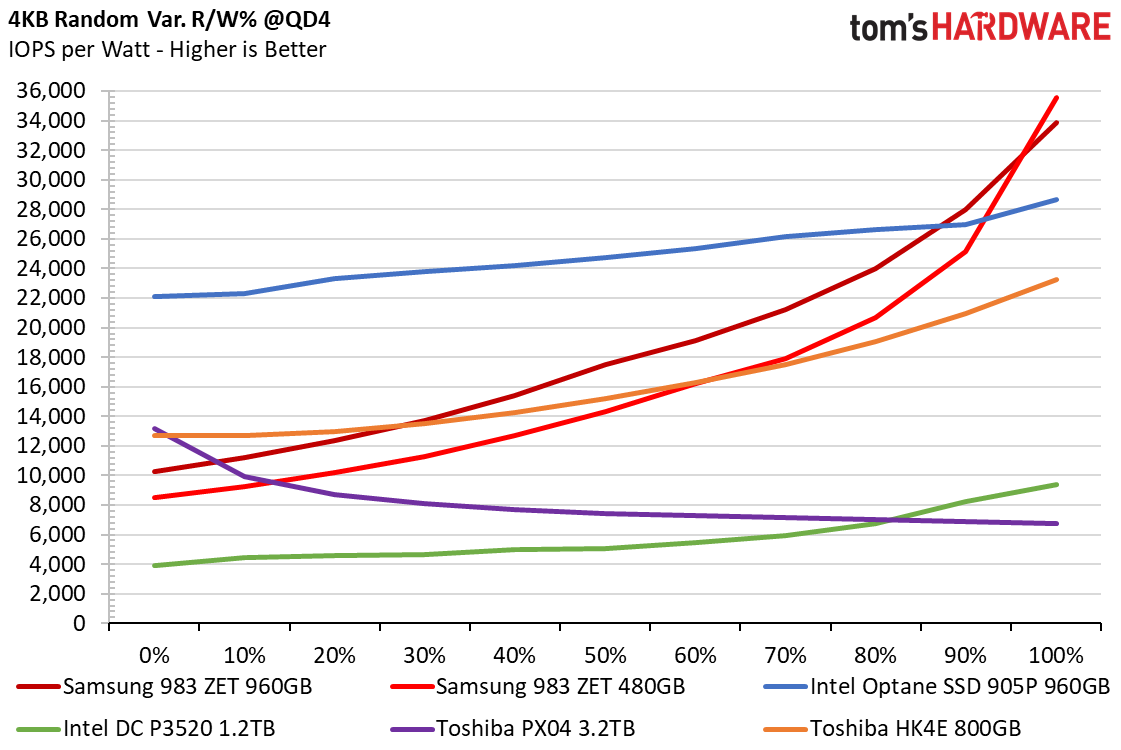
Luckily that is not the case quite yet, but in the past few years, we have seen our fair share of power-thirsty SSD devices. At the 960GB capacity, the Intel Optane 905P consumes upwards of 15W. The 960GB Samsung 983 ZET, on the other hand, consumes approximately half of that at 7.5-8W on average.
But, while the Z-NAND device consumes less power, the sheer performance of Optane plays a huge role in its efficiency. Once you work in random write workloads, the 905P is capable of delivering 2-4x the efficiency of Z-NAND. However, in any other metric, Z-NAND comes out on top.
In pure sequential workloads the 983 ZET can deliver performance of upwards of 350-430MB/s per watt, and in random read workloads, upwards of 100K IOPS per W. Intel’s Optane SSD 905P delivers half of that. In our simple 50GB file copy test of the two, the 983 ZET came out on top as the victor too.
Winner: Samsung Z-NAND. Intel’s Optane offers better random efficiency under pure and mixed write workloads, but overall, Samsung’s Z-NAND offers better efficiency, especially in sequential and random read workloads.
Bottom Line
| Optane | Z-NAND | |
| Endurance | ✗ | ✗ |
| Power Efficiency | Row 2 - Cell 1 | ✗ |
| Latency Performance | ✗ | Row 3 - Cell 2 |
| Random Performance | ✗ | Row 4 - Cell 2 |
| Sequential Performance | Row 5 - Cell 1 | ✗ |
| Productivity/Application Performance | ✗ | Row 6 - Cell 2 |
| Game Load Performance | Row 7 - Cell 1 | ✗ |
| Total | 4 | 4 |
While each has its pros and cons, we don’t necessarily have a winner after today’s bout.
Intel’s Optane is a game-changing memory technology. It exhibits great endurance, ultra-low latency, and is free of the drawbacks of NAND flash. It even has a high price to match its throne. But, Intel’s controller of choice in their Optane based products could use some improvements.
For starters, Team Blue needs to push sequential speed in their next-gen Optane SSD products and kick things up a notch in random read performance. It is amazing that they are able to deliver over 500K IOPS from a consumer product, even under a 70/30% read/write mix, but NAND-based solutions scale higher during heavy load.
Not only that, but with Optane, idle power consumption and overall power consumption is much higher than NAND-based products at the same capacity point, although incredible performance makes up for it somewhat when you look to its efficiency.
Samsung’s optimization of SLC NAND flash is quite impressive, too. With similar low QD read performance and strong sequential throughput, it can keep up with Optane in many workloads. It is also quite power efficient. And while not as expensive, it is still pricey and comes with some performance compromises that 3D XPoint lives without.
With the emergence of other vendors working on their own alternatives to 3D XPoint, who knows what will come. Maybe we will be doing a bout against WD’s ReRAM next time.
Want to comment on this face-off? Let us know what you think in the Tom's Hardware Forums.

Sean is a Contributing Editor at Tom’s Hardware US, covering storage hardware.


